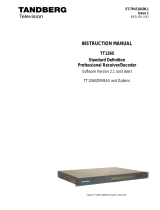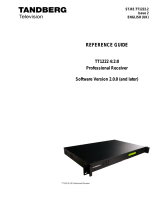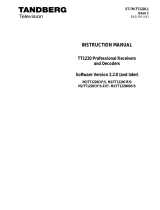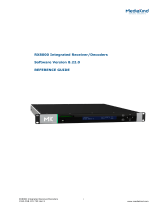Page is loading ...

Assembly Instruction
HDE 164

- 2 - HDE 164
Contents
1 Safety regulations .......................................................................................3
2 General information ....................................................................................4
2.1 Scope of delivery ..........................................................................4
2.2 Meaning of the symbols used ..........................................................4
2.3 Technical data ...............................................................................4
2.4 Description ...................................................................................6
3 Installation ..................................................................................................7
3.1 Installing the Encoder module ..........................................................8
3.2 Connecting the Encoder module ......................................................9
3.3 EMC regulations ............................................................................9
4 The control panel at a glance .....................................................................10
4.1 Functions of the control panel buttons .............................................10
4.2 Menu items .................................................................................10
5 Programming ............................................................................................11
5.1 Programming procedure ...............................................................11
5.2 Programming the module ..............................................................13
Selecting the module / channel strip ..............................................13
Input parameter ...........................................................................14
Data rate of the video signal ....................................................14
TV standard ...........................................................................15
Aspect ratio ...........................................................................15
Sharpness ..............................................................................15
Audio signal type and bit rate ..................................................16
Level of the audio signal ..........................................................16
Programme number (SID - Service ID) ........................................17
Channel name .......................................................................17
ASI Input station filter ...................................................................18
Output parameter ........................................................................20
ASI transfer rate .....................................................................20
ASI options ............................................................................21
Transport stream ID and ORGNET ID .............................................22
Factory reset ...............................................................................22
Saving settings ...........................................................................23
6 Final procedures ........................................................................................23

- 3 - HDE 164
1 safety regulations
• The standards EN/DIN EN 50083 resp. IEC/EN/DIN EN 60728 must be
observed.
• Do not perform installation and service work during thunderstorms.
• Assembly, installation and servicing should be carried out by authorised
electricians.
• Switch off the operating voltage of the system before beginning with assem-
bly or service work.
• Avoid short circuits!
• Observe the relevant standards, regulations and guidelines on the installa-
tion and operation of antenna systems.
• To ensure electromagnetic compatibility, make sure all connections are tight
and the covers are screwed on securely.
• No liability is accepted for damage caused by faulty connections or inap-
propriate handling of the device.
Check the head-end station according to the safety instructions listed in their
assembly instruction.
Take precautions to prevent static discharge when working on the device!
Electronic devices should never be disposed of in the household rubbish. In
accordance with directive 2002/96/EC of the European Parliament and the
European Council from January 27, 2003 which addresses old electronic and
electrical devices, such devices must be disposed of at a designated collection
facility. At the end of its service life, please take your device to one of these
public collection facilities for proper disposal.

- 4 - HDE 164
2 general information
2.1 sCope of delivery
1 Module HDE 164
1 BNC cable
1 Brief assembly instructions
2.2 meaning of the symbols used
Important note
—> General note
–
/
–
/
Optional use of the buttons
• Performing works
2.3 teChniCal data
The devices meet the following EU directives:
2011/65/EU, 2014/30/EU, 2014/35/EU
The product fulfils the guidelines and standards for CE labelling (page 24).
Unless otherwise noted all values are specified as "typical".
CVBS Video Inputs:
Standard: .....................................................................DIN EN 50049-1
Input level: .....................................................................................1 V
pp
Input impedance: ............................................................................75 Ω
Frequency range: .......................................................... 20 Hz … 5 MHz
Audio Inputs:
Standard: .....................................................................DIN EN 50049-1
Input level: ..............................................................................500 mV
rms
Input impedance: .......................................................................... 10 kΩ
Frequency range: ..........................................................20 Hz … 15 kHz
MPEG2 Encoder:
Transport stream: ............................................MPEG2 (ISO/IEC 13818-1)
Video data stream: .........................................MPEG2 (ISO/IEC 13818-2)
Audio data stream: .........................................MPEG1 (ISO/IEC 11172-3)
Output data rate: ..................................................... 2 Mbit/s…15 Mbit/s
Audio data rate: ...................................................... 192 kb/s…384 kb/s

- 5 - HDE 164
ASI Interfaces
Standard: .....................................................................DIN EN 50083-9
Format: ..............................................................MPEG ISO IEC 13818-1
Max. data rate ......................................................................108 Mbit/s
User data rate: .................................................................2 … 90 Mbit/s
Impedance: ....................................................................................75 Ω
Level (input / output): .....................................................800 mV
pp
± 10%
Rise/Fall Time: ............................................................ < 1.2 ns (20-80%)
Reflexion loss (input): ..........................................> 17 dB (5 … 270 MHz)
Connections:
Audio inputs: ............................................................4 x 2 Cinch sockets
CVBS Video inputs: ........................................................ 4 Cinch sockets,
ASI input: .................................................................1 BNC socket, 75 Ω
ASI output: ................................................................1 BNC socket, 75 Ω
Connection strip (20-pin): ....................
for supply voltages and control circuit
Remote maintenance
Remotely controllable (via PSW 160*): ................................................yes
(* and a corresponding management unit)

- 6 - HDE 164
2.4 desCription
In the module HDE 164 four analogue audio and video signals are converted
into MPEG2 data streams (transport streams).
The transport streams are emitted via the ASI output.
L
R
FBAS
CVBS
ASI-Ausgang
ASI output
BNC
ASI-Eingang
ASI input
BNC
Audio-Eingang
Audio input
Cinch
Video-Eingang
Video input
Cinch
ENCODER
AV 1
µP / TPS-MODUL
L
R
FBAS
CVBS
Audio-Eingang
Audio input
Cinch
Video-Eingang
Video input
Cinch
AV 2
L
R
FBAS
CVBS
Audio-Eingang
Audio input
Cinch
Video-Eingang
Video input
Cinch
AV 3
L
R
FBAS
CVBS
Audio-Eingang
Audio input
Cinch
Video-Eingang
Video input
Cinch
AV 4
The module is equipped with four video/stereo audio inputs and one ASI data
stream input. The fed in analogues signals are digitized and supplied to an
encoder that encodes them in real time.
The stereo audio signals are transferred via an adjustable amplifier to the
encoder. The bit rates are adjustable. A transport stream fed via the ASI input
socket will be inserted into the transport streams of the encoded analogous
signals. In this way it is possible to connect several HDE 164 in series.
IN
OUT

- 7 - HDE 164
At the ASI output sockets (BNC) a transport stream is provided according to
ISO/IEC 13818-1.
When the head-end station is switched on, the two-line LC display shows the
"SETUP" menu and the software version of the control unit.
The control of the module takes place via the control unit of the
head-end sta-
tion. To operate the
encoder module
the software version of the control unit
(head-end station) must be "V 10" or higher. The operating software of the
encoder module and the
head-end station can be updated using a PC and
the software "BE-Flash" via the 9-pin D-SUB socket on the head-end station.
You can find the current operating software for the head-end station
and the
encoder module,
the software "BE-Flash"
and the current assembly instructions
on the website "www.mygss.eu".
The
encoder module
is designed exclusively for use in the STC 160 head-end
station.
3 installation
– Ensure the head-end station is mounted so it will not be able to vibrate.
Avoid, for example, mounting the head-end station onto a lift shaft or any
other wall or floor construction that vibrates in a similar way.
– Before installing or changing a module, switch off the head-end station or
unplug the power cable from the mains power socket.
– Take measures to protect against ESD!
•
Open the housing of the head-end station in accordance with the assembly
instructions for the STC 160.

- 8 - HDE 164
3.1 installing the enCoder module
– When installing a module, make sure that it is inserted in one of the long,
numbered grooves in front of the contact strip on the board at the rear wall
of the housing.
– The shorter, non-numbered grooves without a contact strip on the board at
the rear wall of the housing are for add-on modules only.
•
Open the housing of the head-end station in accordance with the assembly
instructions for the STC 160.
• Open the locking device A in the direction of the green arrow.
A
• Insert the Encoder module in grooves B of an open slot (with contact strip
on the board at the rear wall of the housing) and gently slide it into the
head-end station until it makes contact with the board on the rear wall.
• After installing the Encoder module close the locking device A in the direc-
tion of the red arrow.
—> Ensure that the ground spring C gets contact to the locking device.
C
B
B
A

- 9 - HDE 164
3.2 ConneCting the enCoder module
E
D
F
H
G
•
Connect the audio inputs D (right channel) / E (left channel) and video
inputs F to corresponding signal sources.
• If required connect the ASI input G and ASI output H to corresponding
ASI devices (e.g. the ASI output to the ASI input of the next HDE 164 if you
would like to cascade several HDE 164 ; page 6).
3.3 emC regulations
To comply with the current EMC regulations, it is necessary to connect the lines
leading in and out of the head-end station using cable terminals.
When mounting the module in a head-end station which is installed in a 19"
cabinet, make sure the connections leading in and out for the 19" cabinet are
made using cable terminals.
Tighten the nuts on the cable terminals until the teeth on the lock washer have pen-
etrated the exterior coating and a good connection is made between the housing
and cable terminals.

- 10 - HDE 164
4 the Control panel at a glanCe
4.1 funCtions of the Control panel buttons
S
M
To move the cursor
To adjust values and
functions
To save the programmed
data
To switch to the next
menu
4.2 menu items
Program the
Enc
oder module using the buttons on the head-end station control
panel. The menus appear on the two-line display of the control panel.
The parameters and functions to be set are underlined.
With the button select the channel strip / other modules.
You can use the button to select the following menu items:
– ASI output settings
ASI data rate
ASI options
– Input settings
Bit rate
Standard
Aspect ratio
Sharpness
Audio data rate
Volume
Station number
Station name
– Station Filter (ASI input)
– Transport stream and ORGNET-ID
– Factory reset
– Save data

- 11 - HDE 164
5 programming
5.1 programming proCedure
Bx 2
ASI
4xENCODER
V 3
Bx 2
0x0001,0100
TS/ONID
Bx 1
………
………
………
Bx 3
………
> 2 sec. = abbrechen / cancel
………
………
A
Ein/On
Bx 2
AV 1
INPUT
=>
AV 1…4
AV 1…4
10.0 Mbps
BITRATE
AV 1…4
PAL BG
NORM
4.43 MHz
AV 1…4
4:3
ASPECT
AV 1…4
normal
SHARPNESS
AV 1…4
Stereo
AUDIO
256 kbps
AV 1…4 VOLUME
0 dB
AV 1…4
00001
PRG-NUM
AV 1…4
PROG 1
NAME
/Audio only/2…15/off
/PAL N
3.58 MHz
/16:9
/sharp/soft
/Joint/Dual/Mono L
/256/320/384
1…255 !
-11…+11
! = Programmnummer
ist bereits belegt
! = Programme number
is already in use
SETUP
V 10
Bedienhinweise
"blättert" Menüs vorwärts.
wählen die Eingabeposition
wählt Untermenü
stellen Werte ein,.
speichert alle Eingaben.
1 zeigt die Eingabeposition
/
/
M
S
Operating Hints
scrolls forward through the menu.
select the enter position.
selects a submenu.
set values and triggers actions.
saves all entries.
1 shows the enter position
/
/
M
S
/
Bx 2
ASI
INPUT
OK =>
Bx 2
all
all
manual
FILTER
Services entfernen / hinzufügen
Removing / activating services
nächster Service (Programm)
next service (station)
nur bei Einstellung "manual"
Only with setting "manual"
01/04BX 2 TV +
Das Erste
M
M
CANCEL
STORE
Bx 2
S => STORE
MEMORY
A
A
Einstellung speichern
store factory defaults
S
M
MM
A
Bx 2
Defaults
FACTORY
=>
Bx 2
STORE
FACTORY
=> S
Werkeinstellung
aufrufen
invoke factory defaults
S
Bx 2
ASI
OUTPUT
=>
Bx 2
108000 KBits
ASI RATE
Bx 2
188 pos.
/204
/neg.
/burst
1…180 MBits
ASI OPTION
cont.
BE160
page 12

- 12 - HDE 164
Bx 2
ASI
4xENCODER
V 3
Bx 2
0x0001,0100
TS/ONID
Bx 1
………
………
………
Bx 3
………
> 2 sec. = abbrechen / cancel
………
………
A
Ein/On
Bx 2
AV 1
INPUT
=>
AV 1…4
AV 1…4
10.0 Mbps
BITRATE
AV 1…4
PAL BG
NORM
4.43 MHz
AV 1…4
4:3
ASPECT
AV 1…4
normal
SHARPNESS
AV 1…4
Stereo
AUDIO
256 kbps
AV 1…4 VOLUME
0 dB
AV 1…4
00001
PRG-NUM
AV 1…4
PROG 1
NAME
/Audio only/2…15/off
/PAL N
3.58 MHz
/16:9
/sharp/soft
/Joint/Dual/Mono L
/256/320/384
1…255 !
-11…+11
! = Programmnummer
ist bereits belegt
! = Programme number
is already in use
SETUP
V 10
Bedienhinweise
"blättert" Menüs vorwärts.
wählen die Eingabeposition
wählt Untermenü
stellen Werte ein,.
speichert alle Eingaben.
1 zeigt die Eingabeposition
/
/
M
S
Operating Hints
scrolls forward through the menu.
select the enter position.
selects a submenu.
set values and triggers actions.
saves all entries.
1 shows the enter position
/
/
M
S
/
Bx 2
ASI
INPUT
OK =>
Bx 2
all
all
manual
FILTER
Services entfernen / hinzufügen
Removing / activating services
nächster Service (Programm)
next service (station)
nur bei Einstellung "manual"
Only with setting "manual"
01/04BX 2 TV +
Das Erste
M
M
CANCEL
STORE
Bx 2
S => STORE
MEMORY
A
A
Einstellung speichern
store factory defaults
S
M
MM
A
Bx 2
Defaults
FACTORY
=>
Bx 2
STORE
FACTORY
=> S
Werkeinstellung
aufrufen
invoke factory defaults
S
Bx 2
ASI
OUTPUT
=>
Bx 2
108000 KBits
ASI RATE
Bx 2
188 pos.
/204
/neg.
/burst
1…180 MBits
ASI OPTION
cont.
page 11
page 11
page 11

- 13 - HDE 164
5.2 programming the module
Notes:
– Entries are saved by pressing the button.
—> You will be returned to "Selecting the module/channel strip".
– The programming process can be cancelled by pressing and holding the
button.
—> Changes will NOT be saved.
—> You will be returned to "Selecting the module/channel strip".
• Switch on the head-end station.
—>
The display shows "SETUP BE160" and the software
version of the
head-end station (e.g. V 10).
—> The output level of the output collector can be adjusted in the
"SETUP" menu (see STC 160 assembly instructions).
Ein / On
SETUP
V 10
BE160
seleCting the module / Channel strip
• If necessary, press repeatedly to select the particular module (Bx …)
to be programmed.
Bx 2
ASI
4xENCODER
V 3
……… ………
Bx 3
………
………
………
/
—>
The display shows e.g. the menu Bx 2 4xENCODER
ASI V 3.
"Bx 2" stands for slot 2
"4x
ENCODER
" type of module
"V 3" software version of the module

- 14 - HDE 164
• Press the button.
—> The "Input parameter" – "INPUT" main menu is activated.
input parameter
In this menu you select the input, you would like to set the input parameters in
the submenus (AV 1 … AV 4).
Bx 2
AV 1
INPUT
=>
—>
If you do not want to do input settings, press the button. The "ASI
station filter" – "INPUT ASI" main menu is activated (page 18)
• Using the
buttons select the corresponding input.
• Press the
button.
—> The "Data rate of the video signal " – "BITRATE" submenu is acti-
vated.
data rate of the video signal
You can use this menu to set the data rate at which the video signal is to be
encoded. The higher the data rate, the higher the quality of the transmitted
video signal.
AV 1…4
10.0 Mbps
BITRATE
• Use the buttons to set the data rate of the video signal
("2.0" … "15.0" Mbit/sec). If only audio signals are to be encoded, set
the data rate to "Audio only". In setting "Off" the input is switched off.
• Press the button.
—> The
"TV standard" – "NORM" submenu is activated.

- 15 - HDE 164
tv standard
In this menu the
TV standard of the input signal is to be set - "PAL BG 4.43 MHz"
or "PAL N 3.58 MHz".
AV 1…4
PAL BG
NORM
4.43 MHz
• Use the buttons to set the TV standard wished.
• Press the button.
—> The
"Aspect ratio" – "ASPECT" submenu is activated.
aspeCt r atio
In this menu the aspect ratio of the input signal is to be set
- "16:9" or "4:3".
AV 1…4
4:3
ASPECT
• Use the buttons to set the aspect ratio wished.
• Press the button.
—> The "Sharpness"
– "SHARPNESS" submenu is activated.
sharpness
In this menu the you set the sharpness
wished - "normal", "sharp" or "soft".
AV 1…4
normal
SHARPNESS
• Use the buttons to set the sharpness wished.
• Press the button.
—> The
"Audio signal type and bit rate" – "
Audio
" submenu is activated.

- 16 - HDE 164
audio signal t ype and bit rate
In this menu you set the signal type and the bit rate the audio signal is to be
encoded.
AV 1…4
Stereo
AUDIO
256 kbps
• Use the buttons to set the signal type – "Stereo", "Joint Stereo" (sub-
jectively improved stereo impression), "Dual Channel" (dual channel sound)
or "Mono L" (left) - of the audio signal.
• Use the
button to select the bit rate
setting and set it as wished with the
buttons ("192" … "384" kbit/sec).
The higher the bit rate, the higher the quality of the transmitted audio signal.
Bear in mind that when the bit rate is increased, the bandwidth of the output
signal is also increased.
• Press the button.
—> The
"Level of the audio signal" –"VOLUME" submenu is activated.
level of the audio signal
In this menu you can adapt the volume of this audio input.
AV 1…4 VOLUME
0 dB
• Use the buttons to set the desired volume ("– 11dB" … "+ 11dB").
• Press the button.
—> The
"Programme number" –"PRG-NUM" submenu is activated.

- 17 - HDE 164
progr a mme number (sid - serviCe id)
In this menu you can set the Service
ID
of the input.
AV 1…4
00001
PRG-NUM
• Use the buttons to set the Service ID wished ("1" … "255").
—> A "!" behind the Service ID indicates that this ID is already in use by
another input. Using several
HDE 164 (cascading see page 6) don´t
assign the same SID twice.
• Press the button.
—> The
"Channel name" – "NAME" submenu is activated.
Channel na me
In this menu the channel name of the input can be set.
AV 1…4
PROG 1
NAME
• Use the
buttons to
select the digit of the channel name to be set and
use buttons to set the desired character (" ", "0…9", "A…Z", "Ä",
"Ö", "Ü", "a…z", "ä", "ö", "ü", "+", "-", "/", ":" or "*").
• Press the button.
—> Return to the main menu
"Input parameter"
• Use the buttons to select the 2nd AV input and carry out its settings
analogous to that of the 1st AV input, or
• Press the button.
—> The
"ASI Input station filter" – "INPUT" main menu is activated.

- 18 - HDE 164
asi input station filter
Herein you get access to the submenus for ASI input filter settings.
Bx 2
ASI
INPUT
OK =>
—> If no ASI input filter settings should be done, press button .
The "TS ID and ORGNET ID" – "TS/ONID" main menu is activated
(page 22)
—> If no ASI input signal is present, "– –" is displayed instead of "OK".
Bx 2
ASI
INPUT
– – =>
•
Press the
button.
Bx 2
all
FILTER
Using buttons
you can select, whether all services (all) or only selected
services (manual) are passed through.
• Activate the filter function by selecting "manual"
.
• Press the button.
—> All services from the ASI input will be read, and then displayed with
name and type of the service..
—> If no services is found, the following message will appear in the
display: "no Service".
In this case, check previously adjusted settings
for the module and the components connected to the ASI input.
—> The display shows e.g.
:
01/04Bx 2 TV +
Das Erste

- 19 - HDE 164
Meaning of the indicators in the example:
"
TV
" "Television" (type of service)
" + " The currently selected service is passed through
"
01/04
"
The 1st of 4 services is being displayed.
"
Das Erste
" Name of the service
Further possible terms displayed:
"
RA
" "
Radio"
(type of service)
For radio stations, the background of the screen of the
connected TV or test receiver is darkened.
" – "
The currently selected service is blocked.
" * " The star means that the service selected is scrambled.
—> If a service number (e.g. "131") appears instead of "TV" or "RA",
this indicates that an unnamed service or an undefined transport
stream is being received.
•
Use the
buttons to call up the services in sequential order, then use
buttons
to pass through (indicated by "+") or to block them ("–").
—> If the filter function is activated (setting "manual"), only services
which are marked by "+" will be passed. If the services at the ASI
input are changed, new services (which are not marked by "+") will
be blocked.
• Press the button.
—> Return to the main menu
"
ASI input station filter
"
• Press the button.
—> The "Output parameter" – "OUTPUT" main menu is activated.

- 20 - HDE 164
output para meter
In this menu you get access to the output parameter submenus.
Bx 2
ASI
OUTPUT
=>
—> If you do not want to do output settings, press the button.
The
"
Input parameter
" – "INPUT" main
menu is activated
(page 14).
• Press the
button.
—> The "ASI transfer rate" – "ASI RATE" submenu is activated.
asi transfer rate
In this menu you set the transfer rate for the ASI component connected (incl.
stuffing - filled up user data rate).
For this setting please take the required information from the documentation
(technical data) of the ASI component to be connected.
Bx 2
108000 KBits
ASI RATE
• Use the
buttons
to select the digits to be set for the transfer rate then
use the buttons to set the transfer rate wished.
• Press the button.
—> The "ASI options"
– "ASI OPTION" submenu is activated.
/





